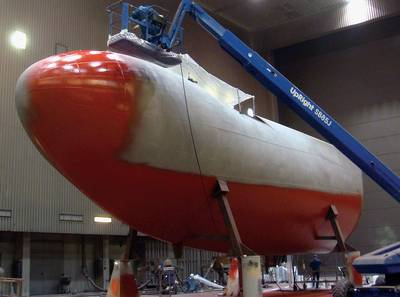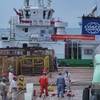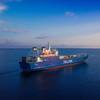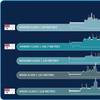Ecospeed Applied on Several Fast-going Ferries, Enabling Optimum Hull Performance During Entire Service Life
Over the last couple of months several owners of fixed route passenger vessels have chosen Ecospeed as the preferred coating to protect their vessel’s underwater hull for its entire sailing life. Among the vessels coated with Ecospeed are the largest Ro-Pax ferry in the world, a newbuild ferry in Croatia, and one of the vessels that provides ferry services across the Delaware Bay on the East Coast of the United States. These vessels will all benefit greatly from the fuel optimizing possibilities Ecospeed offers, as well as the coating’s lasting protection against damage from cavitation and ice.
Under normal operation, ferries have to drydock once a year to comply with classification regulations. During the busy tourist season these ferries need to be sailing to make money so the best time for drydocking is the low season when there are fewer passengers. For this reason the majority of these ferries come into drydock for a short time during the winter months. This presents the owner with bad weather conditions in which to perform repair work to the paint system, and often therefore a quality paint job cannot be assured. For these reasons, it is essential to reduce the necessary maintenance and paint work in drydock.
The initial application of the Ecospeed underwater hull coating can easily be geared to the schedule of the yard. This flexibility can be achieved with Ecospeed because the coating has versatile application potentials. Either of the two required layers can be applied at any time during the building process, even when there is a winter period or serious bad weather between applications.
The durability of Ecospeed also makes the planning of future drydockings far easier for the shipowner and the shipyard. No repainting beyond minor touch-ups will be required. These touch-ups can easily be done during a short drydock visit.
Enhancing the performance of the complete underwater hull
The short drydocking times give ferry operators little opportunity to take all the hull maintenance steps needed to reduce fuel consumption. The use of Ecospeed on the hulls, however, opens the door to looking deeper into how to optimize their fuel efficiency in between dockings. Ferries sail on a fixed route, so the ports they visit and the turnaround time is known in advance. Knowing the exact schedule makes it possible to implement a stricter underwater maintenance program.
Hydrex can help ferry operators with this by monitoring the condition of the ship hull through detailed in-water inspections. Based upon these findings a tailor-made maintenance program can be set up. This, combined with Ecospeed’s performance-enhancing benefits, enables ferry owners to optimize the hulls and thus the fuel efficiency of their vessels. The smoothness attained by the coating provides best hydrodynamic conditions for the vessel to operate at maximum efficiency.
Increased fuel costs are caused by the added resistance characteristics of each coating system that is a consequence of the marine fouling that accumulates on the underwater hull. Towing tank experiments have made it possible to estimate the inherent added drag levels. The rate of increase over time is estimated roughly from data available in scientific literature. Ecospeed's resistance decreases over time, unlike that of other coatings. Regular underwater treatment of Ecospeed is used as a performance enhancement measure. This keeps added drag caused by marine fouling under control. Moreover, this treatment improves the coating’s surface texture and hence its hydrodynamic efficiency. As a result, by adjusting the treatment interval, the increased fuel costs are minimized to significantly lower levels than would be the case for an SPC or foul release paint.
Ecospeed properties prevent fouling penetration, making the cleaning process extremely easy. It can be performed underwater or with high pressure tools in drydock and can be repeated whenever needed during the vessel’s lifespan without causing any damage or deterioration to the coating. The coating’s surface characteristics even improve significantly with each hull cleaning. This unique quality enables shipowners to have their ship’s hull restored to its optimum condition whenever needed. This allows them to have their vessel operational again without the enormous expense of repainting.
Because of the pulsed release of biocides or an increased risk of transferring non-invasive species (NIS), a number of the ports frequented by ferries do not authorize in-water hull cleaning. After the submission of the experimental results of an EU-LIFE demonstration project to port authorities and environmental agencies worldwide, several economically important ports have already overturned the ban on underwater hull cleaning specifically for vessels coated with Ecospeed.
Ecospeed is completely non-toxic
In 2008, stringent tests were carried out within the framework of the aforementioned EU-LIFE demonstration project to provide scientific data and to authenticate the non-toxicity of the Ecospeed hull performance technology. This research proved that the coating is 100% toxin-free and that there is no negative effect on the water quality or the marine environment at any point of its application, sailing or maintenance. This is important for ferry operators who have reduced impact on the environmental high on their agenda. Applying Ecospeed allows them to sail with a completely non-toxic hull coating system.
Some cases in point
World’s largest Ro-Pax ferry sailing with Ecospeed
With a length of 240 meters and combined passenger and freight capacity of 230 cars, 300 freight vehicles and 1,200 passengers, MV Stena Brittanica was launched in October 2010. Owner Stena Line is one of the world’s largest ferry companies with a fleet of 35 modern vessels and Europe’s most comprehensive network consisting of 18 ferry routes in Scandinavia and around the UK.
After a stringent study of the Ecospeed ship hull performance technology, Stena Line opted for a full Ecospeed maintenance contract, consisting of preparation and coating of the underwater hull and routine maintenance to keep it in optimum condition. The first step in this maintenance program was the in-water conditioning of the underwater hull. This conditioning was carried out with specially designed tools and brought the smoothness of the coating’s surface to an optimum condition by aligning the glass platelets inside the vinyl ester matrix. This will allow for an improvement of Ecospeed’s surface characteristics with each further hull cleaning throughout the service life of the vessel.
Stena Line actively works to avoid damage to the marine and land environment. Whenever new operations are being planned or when new technology is being implemented, the environmental consequences are evaluated to minimize the company’s ecological footprint. Designed to have a low environmental impact, Stena Brittanica is built in line with Stena Line's Energy Savings Program. Eco-friendly features include catalytic converters, an improved hull design, highly efficient engines and better combustion rates, all helping to reduce environmental impact. Ecospeed fits in perfectly with these objectives. The coating is 100% environmentally safe, contributes greatly to reduced fuel consumption and therefore GHG emissions, and thus fits perfectly with Stena Line’s own ecological beliefs.
The second decisive factor was the economic benefits that can be obtained through the use of the hull coating system. With Ecospeed the vessel will not have to be repainted, saving the cost of repainting and the additional drydock time required. Regular maintenance will keep the performance of the vessel stable at its optimum level, resulting in significant savings in fuel.
The vessel, which sails between Harwich and Hook of Holland, was built at two different locations in Germany, Warnemunde and Wismar. An Ecospeed application is very easy and can easily be adapted to the building schedule. The application was finished after the blocks were assembled in Wismar, in time for the vessel’s delivery.
Ecospeed protecting underwater hull of Delaware Bay ferry
In early 2011 the underwater hull one of the three 98 meter ferries crossing Delaware Bay from Cape May to Lewes was coated with Ecospeed at the Colonna Shipyard in Norfolk, Virginia.
MV Delaware is owned by the Delaware River and Bay Authority (DRBA) and was one of the original three vessels of the company’s 1970s fleet. Her sister ships are the MV Cape May and MV Twin Capes; the latter is also scheduled to be coated with Ecospeed.
Ice class 1A ferry to sail safely on Canadian South-East coast with Ecospeed
At the end of 2010, Ecospeed was applied to the 95 meter newbuild ferry Bella Desgagnés at the Kraljevica Shipyard in Croatia. The entire application, including surface preparation with grit blasting and application of both layers of Ecospeed, was carried out in only five days.
The vessel is set to replace MV Nordik Express which is due for retirement, after sailing round trips between Rimouski and the Strait of Belle Isle on the East Coast of Canada since 1987. Unlike Nordik Express, which lays up each winter, the ice class 1A Bella Desgagnés will also operate year-round and has been designed for a high ice capability. Ecospeed’s resistance against ice is ideal to complement the vessel’s structural ice protection.
For over four years, several vessels coated with Ecospeed have been sailing the most northern parts of the Baltic Sea during the winter season when they are almost completely frozen. Despite the frequent impact of large pieces of floating dry ice, none of these vessels have required more than just a few touch-ups during their drydock visits. The evidence these dockings gave of Ecospeed’s durability and protection against harsh winter conditions convinced the owners of Bella Desgagnés that the coating was ideal for their newbuild ferry. “We have been looking for a better paint to be applied to our vessels, especially for the vessel going north,” says Mr. Rossi, Vice President and General Manager of Engineering and Operations with Transport Desgagnés Inc. “Bella Desgagnés will operate in first year ice through the winter. If the coating performs in the same manner as we have seen on other vessels, we will have a product that we really wanted on this vessel and on other upcoming new constructions.”
Source: Ecospeed












